A wave of dissatisfaction with the incumbent regimes has spread in a number of North African and Middle Eastern Muslim countries. Some have been hard-hit by this wave, some have survived it, and some are still burning under the fire unleashed not merely by people’s discontentment, but also by the geo-political and geo-strategic interests of the regional and extra-regional powers. The violent and bloody uprising in Syria is as much explanatory of the ‘people’s mood’ as of the major powers’ interests. Syrian crisis is not merely an extension of ‘Arab Spring’; it has a much broader background and historical context in which the role of major powers is irrefutable. Syria—a product of the territorial redistribution of Middle Eastern landmass by the British and French colonial masters after World War 1—is not only a demographic ‘casualty’ in terms of ideologically opposing ethnic communities and races, but also is geographically so located that control over Syria can provide the power(s) dominating it not only access to its Oil, but also, more importantly, domination over the oil and gas export routes through Syria to the European landmass via the Mediterranean. As a matter of fact, Syria is considered to be important not only because of its proven huge Oil reserves 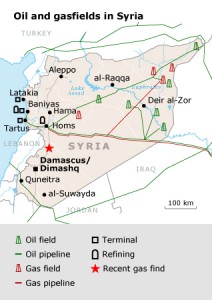 (Syria’s proven oil reserves, amounting to 2.5 billion barrels, are greater than those of all neighboring countries except Iraq: according to the U.S. Energy Information Administration’s estimation of its oil reserves. This makes Syria one of the largest producers and exporters of crude oil in the Middle East); but also because of the short export route it provides. It reinforces the other fact that it is the very geographical location of Syria that places it at the receiving end of ‘energy geo-politics’ of major powers. The Syrian uprising provided the regional and extra regional countries with an opportunity to achieve their spoken and unspoken goals by abetting the armed opposition and paving the way for an ‘international’ intervention, hence civil war. It is in this context that an understanding of the current crisis requires an evaluation of both internal and external dynamics, as also the vital objectives of the major powers involved in this crisis.
(Syria’s proven oil reserves, amounting to 2.5 billion barrels, are greater than those of all neighboring countries except Iraq: according to the U.S. Energy Information Administration’s estimation of its oil reserves. This makes Syria one of the largest producers and exporters of crude oil in the Middle East); but also because of the short export route it provides. It reinforces the other fact that it is the very geographical location of Syria that places it at the receiving end of ‘energy geo-politics’ of major powers. The Syrian uprising provided the regional and extra regional countries with an opportunity to achieve their spoken and unspoken goals by abetting the armed opposition and paving the way for an ‘international’ intervention, hence civil war. It is in this context that an understanding of the current crisis requires an evaluation of both internal and external dynamics, as also the vital objectives of the major powers involved in this crisis.
The Alawites have dominating Syria since 1970s, and it is against this domination of a minority over the majority that the Syrians have taken to arms. The incentive to this uprising might have been provided by the wave of ‘Arab spring’; however, it cannot be gainsaid that, as also testified by T.E. Lawrence in his Seven pillars of Wisdom,(1926) the Syrians cannot tolerate an imposed Government for an indefinite period of time especially the one imposed by foreign elements. The fact that Alawites have been dominating the Syrian politics for last 40 years, and that the Syrians have tolerated this domination can be explained with reference to two other important facts: 1) other minority groups’ support for the Alawites, 2) ferocious security apparatus based on fellow Alawite officers. Allying with Sunni merchant classes in Damascus and Aleppo, the Alawite elite also expanded their influence to the economy as well as the security apparatus and the military. [i] Now when the period of toleration is over, and a strong incentive has been provided by the ‘Arab spring’, the Syrians are still unable to function as a nation. Although a major hurdle in this way is major powers’ interests, diversity and lack of resolution over the solution of war and the future of is also linked to a peculiar factor of the Syrian’s psychological make-up. In order to testify the truth of this observation, we shall again resort to T.E. Lawrence’s observation regarding Syrians’ behaviour pattern. He writes, “They were discontented always with what government they had; such being their intellectual pride; but few of them honestly thought out a working alternative, and fewer still agreed upon one”. Herein lies the dilemma not only of Syrian opposition groups but also of the major powers. The opposition groups, being supported by regional and extra-regional powers,[ii] and the Government are unable to give a united stand and agree on the possible future roadmap for Syria[iii] respectively, and the major powers are unable to get them agreed on a single point agenda; (crucial differences have emerged between US and Al-Nusra front. The US has blacklisted this organization, once welcomed by the US to fight against Assad, and put it on the terror list; while Al-Nusra front has accused US of conspiring to keep Assad in power. On the other hand, the US is fully supporting the National Coalition and has recognized it as the ‘sole’ legitimate representative of Syrian people. Thus deliberately sowing seeds of internal conflict and militancy)[iv], and without doing it, neither the major powers nor the opposing factions would be able to achieve their objectives; for, proliferation of armed groups as well as growing differences amongst them are indicative of the ‘brewing lava’ which can implode anytime, leading to further deterioration of Syria’s socio-political fabric, and uncertain future. These factors certainly point out the likely impediments to the settlement of Syrian crisis, both from the points of view of the Syrian opposition groups/alliances, and of US and its allies for their currently perceptible ‘designs’ of intervention. The deep-rooted ethnic and racial diversity makes not only Syria vulnerable to a prolonged warfare, but also the entire region; for, the ethnic and racial communities are scattered in Iraq, Turkey and other Arab countries as well. The threat of spillover was well highlighted by the UN envoy Kofi Annan when he said, “Syria is not Libya, it will not implode; it will explode beyond its borders.”[v] The strategic location of Syria, its ethnic and racial diversity and internal weakness, deterioration of social fabric as well as militarization of society, as also the US’ policy of dominating the Eurasian region because of its energy potential[vi], link the internal turmoil of Syria to the broader geo-political and geo-energy aspects of the US’ major interests related to the region.
The internal uprising provided the US and its allies with an ‘excuse’ to attempt to execute their long term plans for the region. Although the US was not able to directly intervene in Syria because of Chinese and Russian veto in UNSC, it has resorted to covert means of intervention. The major objective of the US and its allies is to secure oil and gas export from the Gulf States and reduce dependence upon Moscow; for, Moscow’s control over export 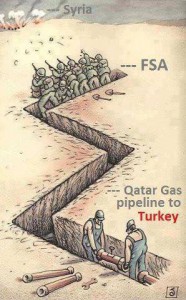 lines gives it immense political power because it can turn off the spigot to Europe whenever relations undergo deterioration. The US and its allies are considering two fundamental oil routes to the West one from Qatar and Saudi Arabia via Jordan and Syria and the Mediterranean to Europe, another from Iran via southern Iraq and Syria to the Mediterranean and on to Europe.[vii] This is what matters; for, minimum dependency upon enemy’s supplied oil is crucial for maintain strategic autonomy as well as influence in the region. Secondly, fall of Assad’s regime would also affect Iran negatively; for Iran, being Shia State, has strong with the Alawites of Syria who also claim to be an offshoot of Shia sect of Islam. Iran has also been using Syria for playing proxy war in Lebanon against Israel. Thus breaking the ‘Shia crescent’ of Iran, Iraq, Lebanon and Syria is one of the major objectives of US and its regional allies, especially States professing Sunni version of Islam, such as Saudi Arabia, Qatar and Turkey. US general Wesley Clerk, wrote Sami Ramadani in Guardian on July 3, 2012, the former supreme commander of allied forces in Europe, once revealed that within weeks of the 9/11 terrorist atrocity the then secretary of defence Donald Rumsfeld described how “we’re going to take out seven countries in five years, starting with Iraq, and then Syria, Lebanon, Libya, Somalia, Sudan and, finishing off, Iran.”
lines gives it immense political power because it can turn off the spigot to Europe whenever relations undergo deterioration. The US and its allies are considering two fundamental oil routes to the West one from Qatar and Saudi Arabia via Jordan and Syria and the Mediterranean to Europe, another from Iran via southern Iraq and Syria to the Mediterranean and on to Europe.[vii] This is what matters; for, minimum dependency upon enemy’s supplied oil is crucial for maintain strategic autonomy as well as influence in the region. Secondly, fall of Assad’s regime would also affect Iran negatively; for Iran, being Shia State, has strong with the Alawites of Syria who also claim to be an offshoot of Shia sect of Islam. Iran has also been using Syria for playing proxy war in Lebanon against Israel. Thus breaking the ‘Shia crescent’ of Iran, Iraq, Lebanon and Syria is one of the major objectives of US and its regional allies, especially States professing Sunni version of Islam, such as Saudi Arabia, Qatar and Turkey. US general Wesley Clerk, wrote Sami Ramadani in Guardian on July 3, 2012, the former supreme commander of allied forces in Europe, once revealed that within weeks of the 9/11 terrorist atrocity the then secretary of defence Donald Rumsfeld described how “we’re going to take out seven countries in five years, starting with Iraq, and then Syria, Lebanon, Libya, Somalia, Sudan and, finishing off, Iran.”
These being the major objectives of the US and its regional allies, attainment of these objectives required the fall of Assad’s regime. Policy of regime change is not something new; the world has already witness this in Iraq, Afghanistan and Libya. But the opposition of two major powers, Russia and China and also of Iran to implementation of any such design has greatly affected the putting of these objectives successfully. The US initially attempted to pursue its objective of regime change by providing help to fighting groups. Al Nusra front was one of them. In the long and bloody struggle, this group came out to be the most organised, powerful and successful of the whole Syrian opposition; but now having the glimpses of success, this group has vowed to establish an Islamic government in Syria — something which is against the US’ national objective, and prejudicial to US’ objectives related to Syria and the region. On the other hand, other fighting groups have thus far been largely reluctant to openly criticize Al-Nusra’s ideology or military tactics, for fear of splitting their ranks and alienating one of the most successful anti-Assad forces in what has become a stalemate on the ground. The Syrian Army has also shown enough resilience, and prevented the opposition groups from taking control of major provinces. It is under these circumstances that the US is now reviewing its strategy. Although things are highly uncertain, there are unconfirmed reports that the US might be considering the option of keeping the Alawite regime in tact in order to secure oil and gas routes through Syria as well as to prevent Syria from implementing its agreement of providing gas pipe line route to the Iranian gas through Iraq and Syria possibly to Europe; for, this would lessen the pressure of the US backed sanctions on Iran. The other option which, according to some analysts, is being considered by the US is of redistribution of Syrian and Middle Eastern borders, hence coming into being of the greater Middle East. According to some published material, especially an article in The Jerusalem Post on May 16 2012 by Jonathan Spyer, the unspoken objective of the US namely the breaking up of Syria into several “independent” states along religious and ethnic lines. The latent objective of the US sponsored insurgency, according to the published material, is—with the help of Israel—“break Syrian into pieces.” Sherkoh Abbas, President of the US based Kurdistan National Assembly of Syria (KNA) has “called on Israel to support the break-up of Syria into a series of federal structures based on the country’s various ethnicities.” Another reference to the plan of “balkanization” of Syria was given in the US Armed Forces Journal by Colonel Ralph Peters as early as in 2006. He contemplated the idea of Greater Kurdistan and prepared a map showing redistribution of physical borders of Middle East. Although his article and the map do not reflect US’ official policy; however, it has been used in a training program at NATO’s Defense College, and other military training institutes for senior military officers’ training.
In either case, balkanization of Syria or emergence of a Kurdish State in Middle East, the entire region will be affected. Kurds, who number around 30 million, are scattered in Turkey and Iraq besides Syria. A Kurdish state would necessarily involve a redistribution of all of these countries’ territorial borders, which may stir strong opposition not only from these states but also trigger other communities’ sentiments for having independent states in the region such as Sunnis in Iraq, Shias in Saudi Arabia, Alawites of Syria. However, there are crucial impediments to the implementation of any such design. The most crucial of them would be regional countries’ opposition; for, redistribution of boundaries would most likely result in the ultimate doom of the old Arab monarchies in the region, which may not be to the advantage of the Western powers; for, it is through these monarchies that the West has been fulfilling its requirements of Oil and Gas. Massive disturbance in the region would result in shortage or even stoppage of supplies which would create enormous difficulties for the Western economic survival. It is because this very “energy factor” that neither Russia nor China would agree to any such plan of redistribution of Middle East; for, if the West could contain the effects of redistribution, it would give it enormous political power vis-à-vis other major powers.
Notwithstanding the above hypothetical scenarios, the emerging ground realities show that the Western as well as Eastern powers will have to attempt seriously to bridge the gap, and pave way for a political settlement. Russia has shown its determination not to allow the West to play havoc in Syria; for, Syria provides its only Mediterranean port in the region. On the other hand, the US and its allies would not agree to completely disregard their interests related to energy. Changing domestic conditions of some of the US’ regional allies such as Turkey are also going to affect future of Syria and Assad’s regime. With Turkey’s Presidential election coming in 2014 as well as brewing political opposition to Erdogan’s foreign policy, Turkey is being faced with limited options. The threat of a Kurdish State coming into being, which would comprise of Syrian and Turkish territory, has put pressure on Turkish leadership, and compelled it to readjust its position. Although these factors reduce chances of US backed NATO intervention, the possibility of prolonged conflict cannot still be ruled out; for, any negotiated political settlement which does not take into account the peculiar demographic realities of Syria and the psyche of the Syrians, which is already extremely stirred up under the given circumstances, is most likely to fail, and brew more conflict and miseries for the people. The Lessons drawn by T.E. Lawrence about the psyche of the Syrians and nature of Syrian socio-political fabric are still relevant today, and can serve as a guide to political settlement.
Salman Rafi Sheikh is a research-analyst of International Relations and Pakistan’s foreign and domestic affairs. He can be contacted at salmanrafisheikh@hotmail.com.
NOTES:
[i] See Reuters’ report of 2 February 2012, another of its report of 7 June 2012, and Jonathan Freedman’s article in Guardian on 20 July 2012.
[ii] Simon Allison, “Analysis: Syria – three wars for the price of one”, Daily Maverick and Asia Times, 28 & 29 August, 2012; (Accessed 30 August 2012)
[iii] Phyllis Bennis, Syria: Only Diplomacy Can stop the War”, Aljazeera, 28 June, 2012; http://www.aljazeera.com/indepth/opinion/2012/06/201262475838515783.html (Accessed 15 October 2012)
[iv] Reported in Business Insider, December 28, 2012,
[v] Phyllis Bennis, Syria: Only Diplomacy Can stop the War”, Aljazeera, 28 June, 2012;
[vi] Emre Iseri, “The US Grand Strategy and the Eurasian Heartland in the Twenty-first Century,” Geopolitics 14 (2009), 6, http://dx.doi.org/10.1080/14650040802578658 (Accessed 1 March 2013)
[vii] Robert Fisk, “Western agreements `could leave Syria in Assad`s hands for two more years”, The Independent, Friday 29, June 2012; http://www.independent.co.uk/voices/commentators/fisk/robert-fisk-western-agreement-could-leave-syria-in-assads-hands-for-two-more-years-7897087.html (Accessed June 30, 2012)
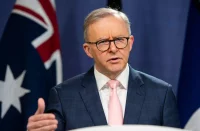
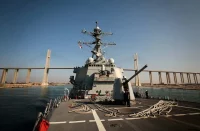
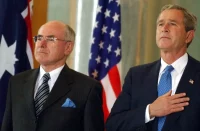











Thank you for an interesting article! One question, though: when and where from the map of Syrian Oil and Gasfields was retrieved? The “recent gas find” interests me…
@Sanna,
We have outsourced the map here.
Pingback: Strijd Syrië niet tegen IS maar voor olie- en gaswinsten